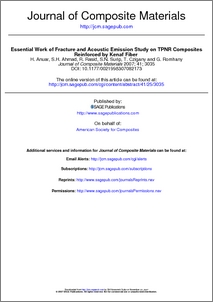Anuar, Hazleen
(2007)
Essential work of fracture and acoustic emission study on TPNR composites reinforced by Kenaf Fiber.
Journal of Composite Materials, 41 (25).
pp. 3035-3049.
ISSN 0021-9983 (P), 1530-793X (O)
![[img]](http://irep.iium.edu.my/style/images/fileicons/application_pdf.png)  Preview |
|
PDF (Essential work of fracture and acoustic emission study on TPNR composites reinforced by Kenaf Fiber)
- Published Version
Download (429kB)
| Preview
|
Abstract
Kenaf fiber (KF) based thermoplastic natural rubber (TPNR)
composite was produced by melt blending with polypropylene (PP). Kenaf fiber
(15% by volume) and TPNR were mixed in as Haake 600p internal mixer.
The fracture behavior of the TPNR matrix and of TPNR–kenaf (with and without
maleic anhydride grafted polypropylene, MAPP) composites was evaluated using the
essential work of fracture (EWF) method and double edge notched tensile (DENT)
specimens. Various ligament lengths were employed ranging from 4 to 12 mm.
The strain rate was fixed at 2 mm/min. The specific work of fracture (we) and plastic
work (bwp) showed the highest energy for TPNR that corresponds to its ductility and
allows the application of the EWF approach. It was found that the presence of kenaf
fibers and MAPP reduced the toughness of TPNR and changed the ductile fracture
to brittle behavior. SEM observation revealed that energy absorption mechanisms
include matrix deformation, fiber pullout, and fiber breakage. Acoustic emission
(AE) was employed to analyze the failure processes further. The signals emitted by
composites were substantially higher than that of the TPNR matrix, reflecting that
also the failure mechanisms were affected by the fibers incorporated.
Actions (login required)
 |
View Item |


 Download Statistics
Download Statistics Download Statistics
Download Statistics